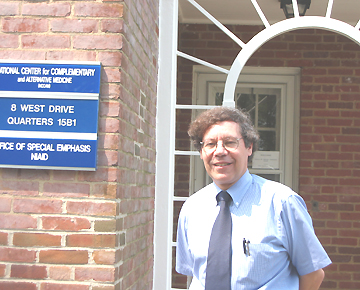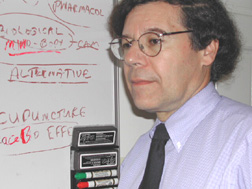
| T H E N I H C A T A L Y S T | S E P T E M B E R – O C T O B E R 2002 |
|
|
|
Interview
with Marc Blackman
|
text
and photos by Fatima Husain |
 |
|
Marc
Blackman
|
As Harvard’s Charles Rosenberg said in July in the debut of the NCCAM series of Distinguished Lectures in the Science of Complementary and Alternative Medicine, up until the late 19th century, all medicine was holistic and multidisciplinary, and what is considered complementary and alternative medicine (CAM) today was considered mainstream medicine then.
Today, however, although it commands an enthusiastic following among the lay public, much of the medical mainstream views CAM somewhat skeptically.
CAM was accorded a niche at NIH when Congress established the Office of Alternative Medicine in 1992. Its goal was to replace both skepticism and enthusiasm with science. In 1998 the office achieved Center status, and in the spring of 2001, Marc R. Blackman became the first clinical director of the newly established NCCAM Division of Intramural Research. Since that time, Blackman has initiated an ambitious intramural clinical research program.
Blackman’s office is in one of the houses across from the Children’s Inn on the NIH Bethesda campus. The number of scientists and staff connected to the NCCAM intramural program has increased substantially, and the cohorts have established quarters at various locations on the Bethesda campus.
Blackman is not a newcomer to NIH—he was a clinical postdoc at NIDDK from 1975 to 1977 and an NIA guest researcher from 1980 to 2001. Before his arrival at NCCAM, he was chief of endocrinology and metabolism and the program director of the General Clinical Research Center at the Johns Hopkins Bayview Medical Center in Baltimore, as well as a professor of medicine at Hopkins.
The Catalyst interviewed Blackman in July, a month after the launch of NCCAM’s first intramural clinical trial—of electroacupuncture to reduce delayed nausea in cancer chemotherapy patients.
Q: First, what was your personal experience with alternative medicine and what attracted you to the position at NCCAM? What was your sense upon arrival here 15 months ago—and what is it now—of NIH’s proper role in exploring and defining alternative therapeutic approaches?
Blackman: Regarding the first question, I’ve had 20 to 25 years of clinical, research, and teaching experience related to endocrinology and aging. The hormones I’ve been interested in—growth hormone, sex hormones, and DHEA (dehydroepiandrosterone)—are also of interest to many in CAM fields. As for other components of CAM, of which there are many, I’d had no experience before coming to NCCAM.
In terms of what attracted me to the position, I viewed it then—and now—as an exciting and challenging opportunity to contribute, with many others, to a huge area of public health interest and concern, namely, the escalating use of CAM modalities by the U.S. public.
I envision collaborating extensively with colleagues inside and outside of NIH and working closely with diverse stakeholders in the field of CAM to create a more robust knowledge of the effectiveness and safety of select CAM modalities . . . and contributing to training and patient care.
At NCCAM, we have established a scientific program centered on the theme of chronic stress. In particular, we have chosen to focus our clinical and translational research efforts on depression, cognitive decline, musculoskeletal frailty, chronic pain and related syndromes, and sleep disorders, particularly in the elderly. Each of these conditions is associated with substantial use of one or another CAM modality.
We have also created an administrative, clinical, and laboratory infrastructure and have begun research programs in endocrinology, diabetes, and oncology.
With time, we intend to establish additional research programs in neurobiology, clinical immunology, cardiovascular medicine, and pharmacology.
During these first 12–15 months, we have initiated our first three clinical research protocols and several laboratory studies, and we have established a series of exciting collaborations with investigators in multiple other institutes.
In addition, we have worked with other NIH colleagues to develop a Clinical Center–based Integrative Medicine Task Force, which we are very excited about.
This task force has several charges. The first is to create an integrative medicine consult service for Clinical Center inpatients and outpatients. This would be novel at NIH and, in fact, at most U.S. institutions. The task force will also oversee licensing, credentialing, and quality assurance of those who apply CAM practices within the NIH Clinical Center.
We also propose to evaluate the success of this entire consultative service, with all its regulatory and educational components, as a health-care research study and to report the results of that assessment in a peer-reviewed journal in the future.
 |
|
Marc
Blackman
|
Q: Do you have the sense that practicing physicians feel uncomfortable about CAM, or that, if presented with the kind of scientific evidence that NCCAM expects to produce, they will modify their practice accordingly?
Blackman: Health-care providers are trained to evaluate information, and they expect and want to be informed properly of the effectiveness, safety, and potential utility of diverse mainstream and CAM interventions. I think that there is a skepticism [among health care providers], which obviously varies from person to person, but in a general sense, it is healthy skepticism based upon the desire for more information.
It’s understandable, given that the majority of CAM modalities have yet to be rigorously evaluated. I think that unhealthy skepticism about CAM practices, based in bias, is far less common.
At NIH, I think there is a growing feeling that CAM represents an area of important research. In fact, during my brief time here, I have been cheered and stimulated by the positive feedback from numerous NIH scientists.
These are highly skeptical people who articulate that there is a compelling need for further investigation of those CAM modalities that show potential to benefit the public’s health.
Q: So much of CAM seems to rest on patient belief structures (mystical belief systems, placebo effect, self-fulfilling prophecy, etc.)—for instance, if a patient believes acupuncture will work, it will. How can NCCAM effectively evaluate those belief systems that are difficult to measure or quantify?
Blackman: You’ve touched upon one of the challenges in CAM-related clinical research. Clearly, the complex integrative systems intrinsic to many CAM practices demand that we develop new paradigms of conceptualization and implementation of clinical investigation.
One example is placebo-related research. About a year and a half or two ago, NCCAM partnered with other NIH institutes to host an extraordinarily successful workshop on the science of the placebo effect. As a consequence of that workshop, interest has grown in more rigorously evaluating the biology of the placebo effect.
Just this year, a Swedish group published some seminal observations in the area of pain interventions that are quite exciting and involve brain imaging [Science 295:1737-1740, 2002].
Q: How do you decide which study to pursue?
Blackman: We work hard to research the relevant literature and to focus on those issues in our areas of research interest that have high public health importance and sufficient evidence to justify further scientific inquiry.
Clearly, we must also ensure that any proposed study is feasible and that we can meet its resource needs. Moreover, we consult with other scientific colleagues and other CAM stakeholders at NIH and in the extramural community.
In our first intramural CAM protocol, we sought to investigate the potential role of electroacupuncture in treating a particularly vexing problem in cancer patients, namely, postchemotherapy nausea and vomiting.
We chose to study young adults in their twenties and thirties with pediatric-type sarcomas in whom chronic and anticipatory postchemotherapy nausea and vomiting are common and greatly reduce quality of life. These patients are treated with multiple successive rounds of highly emetogenic chemotherapy at three-week intervals. Glucocorticoids and other antiemetic drugs fail to curb the nausea and vomiting and are associated with major side effects.
Although electroacupuncture has proved beneficial in the management of nausea and vomiting occurring acutely (within 24 hours) postchemotherapy, it has not yet been investigated for such symptoms occurring chronically (2–5 days). Our study will address this issue in a controlled fashion.
Another of our intramural clinical studies will address endocrine-immune relationships in premenopausal women with recently detected rheumatoid arthritis. We hypothesize that the heightened inflammatory milieu of these patients, typified by augmented cytokine activity, is associated with suppressed growth hormone and DHEA production and that the effects of endocrine-immune disruption contribute to important extra-articular manifestations of arthritis—specifically, osteopenia, sarcopenia, increased body fat, and increased risk of diabetes and cardiovascular disease.
From a CAM perspective, we are interested in both the joint and extra-articular manifestations of rheumatoid arthritis.
In subsequent studies, we hope to evaluate the effects of modulating the growth hormone or DHEA axis, in conjunction with the best of the mainstream antirheumatoid arthritis medications.
Q: How do you and your various collaborators settle on experimental paradigms and protocol details?
Blackman: As you know well, scientific collaboration requires coming to a consensus with one’s colleagues and collaborators as to the specifics of the hypothesis, specific aim, experimental design and method, and analysis, interpretation, and reporting of data.
Clinical research in CAM poses additional challenges regarding novel approaches to design, especially with regard to experimental controls. Needless to say, we and our colleagues discuss these thoroughly in our planning sessions. Planning for our acupuncture study served as a good example of this process.
We also routinely send our nascent protocols for independent scientific evaluation by experts not involved in the study before submitting the final protocol to the Institutional Review Board.
Q: What lies ahead?
Blackman: During the next several years, we plan to build our intramural program and to work closely with colleagues here at NIH to substantially expand our CAM-related research, clinical, and educational activities.
One of our goals, among many, is over time to incorporate chiropractic research into some aspects of our clinical investigations of musculoskeletal disorders.
Chiropractic is a good area to explore because it is a well-criticized field with well-documented types of training. Properly done, I think this would be a substantial contribution to research and to the care of patients with certain musculoskeletal disorders.
I’ve been quite cheered
by the positive reception accorded our initial efforts by colleagues at NIH,
and I believe that their scientific goals are consonant with the perspective
of the general public, which desires that we bring the best of complementary
and alternative medicine into the mainstream. ![]()